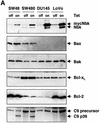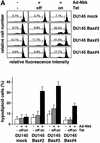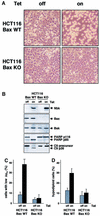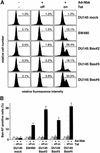Induction of cell death by the BH3-only Bcl-2 homolog Nbk/Bik is mediated by an entirely Bax-dependent mitochondrial pathway
- PMID: 12853473
- PMCID: PMC165613
- DOI: 10.1093/emboj/cdg343
Induction of cell death by the BH3-only Bcl-2 homolog Nbk/Bik is mediated by an entirely Bax-dependent mitochondrial pathway
Abstract
Nbk/Bik (natural born killer/Bcl-2-interacting killer) is a tissue-specific BH3-only protein whose molecular function is still largely unknown. To investigate the mechanism of Nbk action, we established a single- vector adenoviral system based on the Tet-off conditional expression of Nbk. Upon Nbk expression, only Bax-positive, but not Bax-deficient cells were found to undergo apoptosis. Interestingly, Nbk failed to induce apoptosis in the absence of Bax, even despite expression of the related molecule Bak. Re-expression of Bax restored the sensitivity to Nbk. Similarly, Bax wild-type HCT116 cells were highly susceptible, whereas HCT116 Bax knock-out cells remained resistant to Nbk-induced apoptosis. In Bax-positive cells, Nbk induced a conformational switch in the Bax N-terminus coinciding with cytochrome c release, mitochondrial permeability transition and caspase-9 processing. Immunoprecipitation studies revealed that Nbk interacts with Bcl-x(L) and Bcl-2 but not with Bax. Since, in addition, Nbk did not localize to the mitochondria, our data suggest a model in which Nbk acts as an indirect killer to trigger Bax-dependent apoptosis, whereas Bak is not sufficient to confer sensitivity to Nbk.
Figures












Similar articles
-
Caspase-independent induction of apoptosis in human melanoma cells by the proapoptotic Bcl-2-related protein Nbk / Bik.Oncogene. 2005 Nov 10;24(49):7369-80. doi: 10.1038/sj.onc.1208890. Oncogene. 2005. PMID: 16007125
-
Smac induces cytochrome c release and apoptosis independently from Bax/Bcl-x(L) in a strictly caspase-3-dependent manner in human carcinoma cells.Oncogene. 2004 Jun 3;23(26):4523-35. doi: 10.1038/sj.onc.1207594. Oncogene. 2004. PMID: 15064710
-
Involvement of proapoptotic molecules Bax and Bak in tumor necrosis factor-related apoptosis-inducing ligand (TRAIL)-induced mitochondrial disruption and apoptosis: differential regulation of cytochrome c and Smac/DIABLO release.Cancer Res. 2003 Apr 1;63(7):1712-21. Cancer Res. 2003. PMID: 12670926
-
Mechanisms of cytochrome c release by proapoptotic BCL-2 family members.Biochem Biophys Res Commun. 2003 May 9;304(3):437-44. doi: 10.1016/s0006-291x(03)00615-6. Biochem Biophys Res Commun. 2003. PMID: 12729577 Review.
-
Mitochondrial membrane permeabilisation by Bax/Bak.Biochem Biophys Res Commun. 2003 May 9;304(3):455-61. doi: 10.1016/s0006-291x(03)00617-x. Biochem Biophys Res Commun. 2003. PMID: 12729579 Review.
Cited by
-
Bik/NBK accumulation correlates with apoptosis-induction by bortezomib (PS-341, Velcade) and other proteasome inhibitors.Oncogene. 2005 Jul 21;24(31):4993-9. doi: 10.1038/sj.onc.1208683. Oncogene. 2005. PMID: 15824729 Free PMC article.
-
MTCH2/MIMP is a major facilitator of tBID recruitment to mitochondria.Nat Cell Biol. 2010 Jun;12(6):553-562. doi: 10.1038/ncb2057. Epub 2010 May 2. Nat Cell Biol. 2010. PMID: 20436477 Free PMC article.
-
Cytomegalovirus cell death suppressor vMIA blocks Bax- but not Bak-mediated apoptosis by binding and sequestering Bax at mitochondria.Proc Natl Acad Sci U S A. 2004 May 25;101(21):7988-93. doi: 10.1073/pnas.0401897101. Epub 2004 May 17. Proc Natl Acad Sci U S A. 2004. PMID: 15148411 Free PMC article.
-
Genetic dissection of apoptosis and cell cycle control in response of colorectal cancer treated with preoperative radiochemotherapy.BMC Cancer. 2006 May 10;6:124. doi: 10.1186/1471-2407-6-124. BMC Cancer. 2006. PMID: 16686938 Free PMC article.
-
Tumor necrosis factor α-induced protein 8-like 1 promotes apoptosis by regulating B-cell leukemia/lymphoma-2 family proteins in RAW264.7 cells.Oncol Lett. 2016 Nov;12(5):3506-3512. doi: 10.3892/ol.2016.5090. Epub 2016 Sep 5. Oncol Lett. 2016. PMID: 27900028 Free PMC article.
References
-
- Borner C. (2003) The Bcl-2 protein family: sensors and checkpoints for life-or-death decisions. Mol. Immunol., 39, 615–647. - PubMed
-
- Boyd J.M. et al. (1995) Bik, a novel death-inducing protein shares a distinct sequence motif with Bcl-2 family proteins and interacts with viral and cellular survival-promoting proteins. Oncogene, 11, 1921–1928. - PubMed
-
- Cheng E.H., Wei,M.C., Weiler,S., Flavell,R.A., Mak,T.W., Lindsten,T. and Korsmeyer,S.J. (2001) Bcl-2, Bcl-xL sequester BH3 domain-only molecules preventing Bax- and Bak-mediated mitochondrial apoptosis. Mol. Cell, 8, 705–711. - PubMed
-
- Daniel P.T., Pun,K.T., Ritschel,S., Sturm,I., Holler,J., Dörken,B. and Brown,R. (1999) Expression of the death gene Bik/Nbk promotes sensitivity to drug-induced apoptosis in corticosteroid-resistant T-cell lymphoma and prevents tumor growth in severe combined immunodeficient mice. Blood, 94, 1100–1107. - PubMed
Publication types
MeSH terms
Substances
LinkOut - more resources
Full Text Sources
Other Literature Sources
Research Materials

